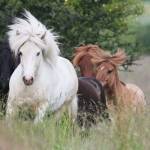Control of Feral Horses in Australia: Repellents

Australia has a very large feral horse population—well over 400,000—and these animals are blamed for degrading the environment, eating grass desired for commercial livestock production, and possibly acting as a reservoir of disease. Feral horses are sometimes shot, trapped for relocation, rounded up for slaughter, or adopted by private citizens.
In the search for nonlethal, humane management options to keep feral horses away from certain areas, the use of various repellents has been suggested. Researchers* tested heart rate response of domestic horses to 23 noises, odors, or sights that could be used as repellents. Stimuli evoking the strongest responses, and therefore suggesting that horses felt stressed or fearful when facing these stimuli, might be the most effective in repelling feral horses.
Twelve mature Standardbred mares were restrained in breeding stocks and exposed to stimuli that were presented in random order. Heart rates were recorded for all horses as they were exposed to the stimuli. Noises as a category produced the greatest reaction, with horses showing increased heart rates in response to every sound used. Some sights produced no reaction, though horses did react to seeing a horse skeleton, a silhouette of a lioness, and an umbrella being opened. Odors that produced significant reactions included fermented egg, dingo urine, tiger feces, blood/bone, and a liquid lure used to attract coyotes and foxes to a trap.
Though there were consistent heart rate changes to a range of stimuli, reactions differed among various mares in the study group. If further testing revealed several stimuli that repeatedly repelled all horses, it is possible that these sounds, sights, or odors could be incorporated into methods to keep feral horses in or out of various locations. Limiting the range of feral horses would reduce their impact on the habitats of native plants and animals, and repellents might also be used to guide horses toward traps.
*More information on “Heart rate response of restrained domesticated horses to potential feral horse repellents” can be found here.








